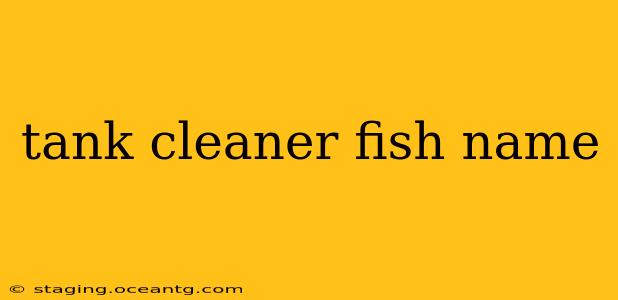Keeping a clean aquarium is crucial for the health and happiness of your fish. While regular water changes are essential, introducing tank cleaner fish can significantly reduce the workload and provide a natural, fascinating way to maintain a healthy environment. But with so many species available, choosing the right one can feel overwhelming. This guide will explore some popular tank cleaner fish, their characteristics, and help you decide which species best suits your aquarium.
What are the best types of tank cleaner fish?
This is a frequently asked question, and the answer depends largely on the size and type of your aquarium, as well as the existing inhabitants. Some popular choices include:
-
Siamese Algae Eaters (SAE): These fish are highly effective at controlling algae, especially hair algae and other types of nuisance algae. They're relatively peaceful and can thrive in community tanks. However, they can become picky eaters as they mature and might not tackle all types of algae.
-
Otocinclus Catfish (Oto): Another excellent algae eater, Otos are small and peaceful, perfect for smaller tanks. They prefer softer algae and biofilm, so they're best suited for tanks with established algae growth. It's crucial to acclimate them slowly, as they can be sensitive to water parameter changes.
-
Nerite Snails: While not technically fish, Nerite snails are incredibly efficient at cleaning algae from aquarium surfaces, including glass, decor, and plants. They're low-maintenance and come in various attractive shell patterns. However, they can be selective in the types of algae they consume.
-
Amano Shrimp: Similar to snails, Amano shrimp are effective algae eaters. They're active and enjoyable to watch, adding a dynamic element to your tank's ecosystem. They're relatively hardy but prefer cooler water temperatures.
-
Mystery Snails: These large snails are voracious eaters and can help clean up uneaten food and decaying matter. They’re a great addition to larger tanks.
What fish clean the bottom of the tank?
Several fish species excel at cleaning the bottom of the aquarium, effectively removing uneaten food and debris. While not solely dedicated to bottom cleaning, these fish contribute significantly to a clean tank environment:
-
Corydoras Catfish: These peaceful bottom dwellers are excellent scavengers. They sift through the substrate, consuming leftover food and decaying organic matter. Their activity also helps aerate the substrate. Different Corydoras species exist, each with varying size requirements.
-
Plecostomus (Pleco): While some species can grow extremely large, smaller Pleco varieties can be suitable for certain aquariums. They're powerful algae eaters and can also consume detritus from the substrate. However, be aware of their potential growth, as many require larger tanks as they mature.
-
Hillstream Loaches: These unique fish prefer a strong current and thrive on the biofilm that forms on rocks and decorations in the tank.
Which is the best tank cleaner fish for a beginner?
For beginner aquarists, Otocinclus catfish and Nerite snails are often recommended. Otos are relatively hardy and peaceful, making them suitable for community tanks. Nerite snails are incredibly low-maintenance and require minimal care. However, both require careful acclimation to ensure their survival.
What kind of fish eats algae?
Many fish species effectively control algae growth. The best choice depends on the type of algae and the size of your tank:
- Siamese Algae Eaters (SAE) are effective against hair algae.
- Otocinclus Catfish (Oto) prefer softer algae and biofilm.
- Nerite Snails are great for various algae types.
- Amano Shrimp efficiently consume numerous algae varieties.
- Plecostomus (Pleco) are potent algae eaters but can grow large.
How do I choose the right cleaner fish for my aquarium?
Choosing the right cleaner fish involves considering several factors:
- Tank size: Larger tanks can accommodate larger cleaner fish. Smaller tanks require smaller, less demanding species.
- Existing inhabitants: Ensure the cleaner fish is compatible with your existing fish. Avoid aggressive or territorial species that might harass or harm your cleaner fish.
- Algae type: Different cleaner fish are more effective against specific algae types.
- Water parameters: Certain cleaner fish have specific water parameter requirements (temperature, pH, etc.).
By carefully considering these factors, you can select the most appropriate cleaner fish to maintain a healthy and thriving aquarium. Remember to research the specific needs of any fish before introducing it to your tank. A well-maintained aquarium with appropriate cleaner fish contributes to a vibrant and enjoyable aquatic environment.
